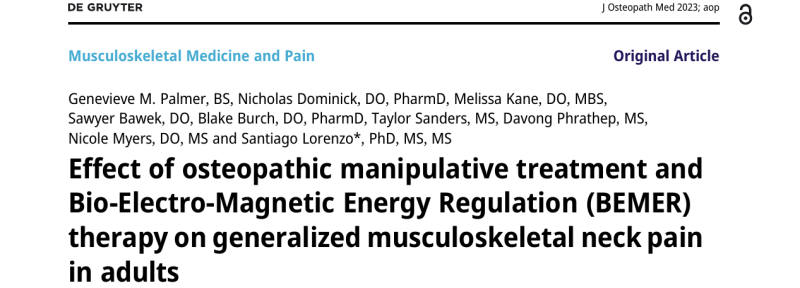Studies 2023
Treatment of patients with multiple organ dysfunction syndrome (MODS) with an electromagnetic field coupled to biorhythmically defined impulse configuration: the MicrocircMODS study
Karl Werdan1 · Sebastian Nuding1,2 · Diethelm Kühnert1,3 · Ramzi Kolthoum1 · Artjom Schott1 · Felix Quitter4 · Andreas Wienke5 · Daniel Sedding1
Abstract
Background To potentially improve impaired vasomotion of patients with multiple organ dysfunction syndrome (MODS), we tested whether an electromagnetic field of low flux density coupled with a biorhythmically defined impulse configuration (Physical Vascular Therapy B EMER®, PVT), in addition to standard care, is safe and feasible and might improve disturbed microcirculatory blood flow and thereby improve global haemodynamics.
Methods In a prospective, monocentric, one-arm pilot study, 10 MODS patients (APACHE II score 20–35) were included. Patients were treated, in addition to standard care, for 4 days with PVT (3 treatment periods of 8 min each day; day 1: field intensity 10.5 μT; day 2:14 μT, day 3:17.5 μT; day 4:21.0 μT). Primary endpoint was the effect of PVT on sublingual microcirculatory perfusion, documented by microvascular flow index (MFI). Patient safety, adverse events, and outcomes were documented.
Results An increase in MFI by approximately 25% paralleled 4-day PVT, with the increase starting immediately after the first PVT and lasting over the total 4-day treatment period. Concerning global haemodynamics (secondary endpoints), halving vasopressor use within 24 h, and haemodynamic stabilisation paralleled 4-day PVT with an increase in cardiac index, stroke volume index, and cardiac power index by 30%–50%. No adverse events (AEs) or serious adverse events (SAEs) were classified as causally related to the medical product (PVT) or study. Three patients died within 28 days and one patient between 28 and 180 days.
Conclusion PVT treatment was feasible and safe and could be performed without obstruction of standard patient care. An increase in microcirculatory blood flow, a rapid reduction in vasopressor use, and an improvement in global haemodynamics paralleled PVT treatment. Findings of this pilot study allowed forming a concept for a randomized trial for further proof.
Genevieve M. Palmer, BS, Nicholas Dominick, DO, PharmD, Melissa Kane, DO, MBS, Sawyer Bawek, DO, Blake Burch, DO, PharmD, Taylor Sanders, MS, Davong Phrathep, MS, Nicole Myers, DO, MS and Santiago Lorenzo*, PhD, MS, MS Effect of osteopathic manipulative treatment and Bio-Electro-Magnetic Energy Regulation (BEMER) therapy on generalized musculoskeletal neck pain in adults
Abstract
Context: General neck pain is a prevalent complaint made by patients to their physicians and is often of a suspected musculoskeletal origin. Osteopathic manipulative treatment (OMT) is a form of manual therapy utilized by osteopathic physicians and some allopathic physicians to treat a broad variety of musculoskeletal ailments, including neck pain. BioElectro-Magnetic Energy Regulation (BEMER) is an emerging therapeutic modality that deploys a biorhythmically defined stimulus through a pulsed electromagnetic field and has been shown to reduce musculoskeletal pain. Studies on these treatments have independently yielded promising results.
Therefore, it is possible that the utility of OMT and BEMER can produce an additive improvement in the treatment of neck pain
Critical Lower Extremity Ischemia and Physical Vascular Therapy, Bemer®
Taking anabolic steroids is associated with many side effects, including hormonal effects, liver damage, blood pressure increase, concentric left ventricular hypertrophy, damage to fat metabolism, immune damage, skin symptoms and arterial thrombosis. In the presented case, the 46-year-old man used anabolic steroids as a cure for 10 years. When he was admitted to the hospital, he complained of pain in his left leg for three days, which was caused by blockage of the left iliac and popliteo-crural arteries. An embolectomy was performed, supplemented with a fasciotomy. Two days later, a CT angiography performed due to an increase in complaints showed a floating thrombus in the left common iliac artery and repeated occlusion of the leg vessels. The CT also showed damage to the liver, right kidney, intestines, and partial thrombosis of the superior mesenteric artery. Repeated lower extremity embolectomy did not yield definitive results. There was an increased chance of possible limb loss. The ischemia of the limb requiring opiate analgesia was compensated with vasodilator infusion treatment, as the source of the central embolism was not confirmed. The fasciotomy wound showed a tendency to heal with regular surgical control. Upon discharge of the patient, after detailed information, we prescribed medications, special nutrients, physical vascular therapy and weekly bandage changes at our specialist ambulance. Thanks to the patient’s cooperation, it was possible to achieve complete recovery and return to his previous work. If the surgical thrombectomy is not successful, there is a possibility of limb loss due to critical limb ischemia, prostacyclin treatment is recommended even in the hospital. If the infusion proves to be effective, the limb can be saved by using physical vascular therapy (BEMER®) six times a day at the patient’s home. In case of critical limb ischemia, BEMER® proves to be a good choice and is recommended.
Keywords: Arterial Embolism; Anabolic Steroid Abuse; Critical Lower Limb Ischemia; Chronic Wounds; Iloprost; Physical Vascular Therapy; Bio-Electro-Magnetic-Energy-Regulation (Bemer®)



